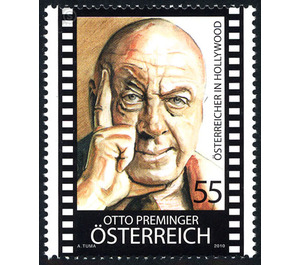Austrians in Hollywood - Austria / II. Republic of Austria 2010 - 55 Euro Cent
Theme: Art & Culture
| Country | Austria / II. Republic of Austria |
| Issue Date | 2010 |
| Face Value | 55.00 |
| Edition Issued | 900,000 |
| Printing Type | offset |
| Stamp Type | Commemorative |
| Item Type | Stamp |
| Chronological Issue Number | 2187 |
| Chronological Chapter | OOS-OE2 |
| SID | 867789 |
| In 62 Wishlists | |
Otto Preminger (1905 - 1986) was an Austrian-American film director, film producer, theater director and theater director from an assimilated Jewish family. The son of a magistrate first studied law in Vienna and graduated in 1928 with the doctorate. Already during this time he devoted himself by the way to acting, appeared in small roles under Max Reinhardt at the Theater in der Josefstadt and was his assistant in Salzburg. Larger roles he played mainly at the Deutsches Theater in Prague. Finally, in 1925 he directed for the first time - and in 1931 he returned to the theater in the Josefstadt, whose director he was from 1933 to 1935. In 1931, Otto Preminger made his first film ("The Great Love"), which made him, as well as his theatrical productions in Hollywood and New York, known to a wider audience. In October 1935 he went to the United States, where he created numerous films and participated in several stripes as an actor, but without neglecting his activities in the theater. In 1953 Preminger founded his own production company and from then on he no longer had to take Hollywood's filmic specifications of the "dream factory" into consideration. In 1955, he opened a taboo with "The Man with the Golden Arm," a portrait of a drug addict in the slums of Chicago. Not least his film "Anatomy of a Murder" contributed to the fact that the internal censorship was subverted more often and subsequently completely abandoned. Ultimately, it was also Otto Preminger, who shot the first strip with exclusively black actors: "Carmen Jones" after Georges Bizet's opera "Carmen". Another central work in Premingers cinematic work is "Bonjour Tristesse" after the novel by Francoise Sagan; This film was celebrated with hymn-like critics and had, as the experts agree, for the future directors of the French "Nouvelle Vague" a role model character. Otto Preminger, who is immortalized on the legendary "Walk of Fame" in Hollywood, always designed an inner panorama of his protagonists whose soul worlds he explored deeply. Although he drove the actors to their very best, he kept that necessary distance so as not to slip into the melodramatic. In a balancing act of emotion and analysis, the nuances between details and structured whole, he condensed his films into complex narratives that literally "get under the skin". As a "director of soft tones" (quote "film time") Otto Preminger wrote a significant piece of cinema history.


